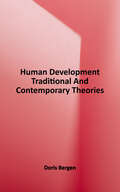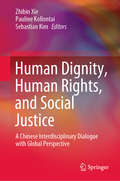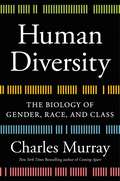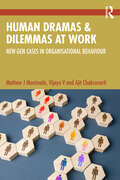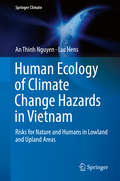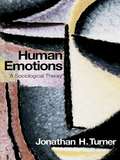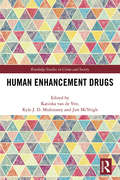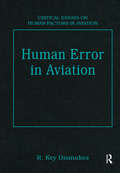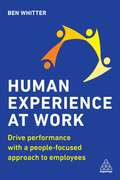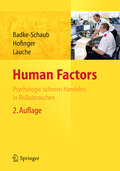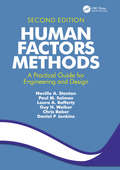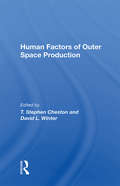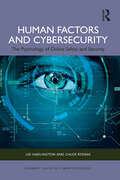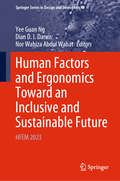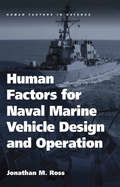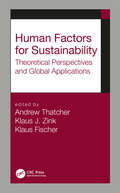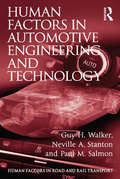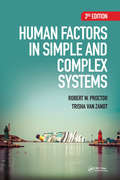- Table View
- List View
Human Development: Traditional and Contemporary Theories
by Doris BergenFor courses in human development, theories of development and development over the lifespan. Throughout years of teaching various courses in psychology, Doris Bergen struggled with a familiar problem in Human Development classes: the texts available to her did not meet the needs of the types of students in her classes. In teaching students who were primarily working towards degrees in professional practice, rather than those focusing on advanced degrees in psychology, the current texts did not present theoretical work in a way that helped her students translate the concepts into their careers. Here, Doris Bergen has authored a text that does just that. By making the theoretical issues relevant and accessible to students going into professional practice, enabling them to apply theory to case examples, and helping them see which theories are focused primarily on specific developmental domains, this text will give students the edge they need as they move forward in their working lives.
Human Dignity, Human Rights, and Social Justice: A Chinese Interdisciplinary Dialogue with Global Perspective
by Pauline Kollontai Sebastian Kim Zhibin XieThis book explores human dignity, human rights and social justice based on a Chinese interdisciplinary dialogue and global perspectives. In the Chinese and other global contexts today, social justice has been a significant topic among many disciplines and we believe it is an appropriate topic for philosophers, theologians, legal scholars, and social scientists to sit together, discuss, enrich each other, and then deepen our understanding of the topic. Many of them are concerned with the conjuncture between social justice, human rights, and human dignity. The questions this volume asks are: what’s the place of human rights in social justice? How is human dignity important in the discourse on human rights? And, through these inquiries, we ask further: how is possible to achieve humanist justice? This volume presents the significance, challenges, and constraints of human dignity in human rights and social justice and addresses the questions through philosophical, theological, sociological, political, and legal perspectives and these are placed in dialogue between the Chinese and other global settings. We are concerned with the norms regarding human dignity, human rights and social justice while we take seriously into account their practice. This volume consists of two main sections. The first section examines Chinese perspectives on human rights and social justice, in which both from Confucianism and Christianity are considered and the issues such as patriotism, religious freedom, petition, social protest, the rights of marginalized people, and sexual violence are studied. The second section presents the perspectives of Christian public theologians in the global contexts. They examine the influence of Christian thought and practice in the issues of human rights and social justice descriptively and prescriptively and address issues such as religious laws and rights, diaconia, majoritarianism, general equality, social-economic disparities, and climate justice from global perspectives including in the contexts of America, Australia, Israel and Europe. With contributions by experts from mainland China, Hong Kong, South Korea, Australia, New Zealand, the UK, USA and Norway, the book provides valuable cross-cultural and interdisciplinary insights and perspectives. As such it will appeal to political and religious leaders and practitioners, particularly those working in socially engaged religious and civil organizations in various geopolitical contexts, including the Korean Peninsula and Japan.
Human Diversity: The Biology of Gender, Race, and Class
by Charles MurrayAll people are equal but, as Human Diversity explores, all groups of people are not the same -- a fascinating investigation of the genetics and neuroscience of human differences.The thesis of Human Diversity is that advances in genetics and neuroscience are overthrowing an intellectual orthodoxy that has ruled the social sciences for decades. The core of the orthodoxy consists of three dogmas:- Gender is a social construct.- Race is a social construct.- Class is a function of privilege. The problem is that all three dogmas are half-truths. They have stifled progress in understanding the rich texture that biology adds to our understanding of the social, political, and economic worlds we live in.It is not a story to be feared. "There are no monsters in the closet," Murray writes, "no dread doors we must fear opening." But it is a story that needs telling. Human Diversity does so without sensationalism, drawing on the most authoritative scientific findings, celebrating both our many differences and our common humanity.
Human Dramas and Dilemmas at Work: New-Gen Cases in Organisational Behaviour
by Mathew J Manimala Vijaya Venkateswaran Ajit ChakravartiThis book presents 120 real-life case-studies collected from indigenous as well as multinational organizations operating in India in 18 different industry sectors. These cases provide the readers with insights into ‘the good, the bad and the ugly’ facets of the corporate lives of new-gen professionals in the last two decades.Based on real-life work experiences of corporate executives in India, these cases address a variety of the multitude of issues being faced by the professionals and their behavioural implications at the workplace. There is considerable diversity in the themes and issues discussed in these cases. To facilitate the teaching and learning, the book provides an introductory part comprising a brief exposition of ‘OB as a discipline’. The second part of the book contains the abstracts of all cases along with questions for discussion. Thematically designed and comprehensive in coverage, the book covers almost all issues in the subject-areas of OB and HRM. The book is divided under ten sub-themes, namely: Personality, Perception and Communication, Attitudes and Values, Leadership, Power and Politics, Jobs and Roles, Conflict and Collaboration, Group and Team Dynamics, Culture and Diversity, and Managing Change. Each case is also identified under subthemes for the case facilitator to discuss, when suitable.This book will be useful to the students, academics, management researchers, industry professionals from the field of general management, organisational behaviour and human resource management and Commerce. It would also be a useful resource for professionals and the general reader as it provides an opportunity to learn through surrogate experience.
Human Ecology of Climate Change Hazards in Vietnam: Risks for Nature and Humans in Lowland and Upland Areas (Springer Climate)
by An Thinh Nguyen Luc HensThis book analyzes climate change associated effects in the mountainous and coastal environments of Vietnam. The scope of the book allows international comparisons to be made between these two affected areas and other similarly affected locations under constant environmental pressure. Frequent and intense climate change hazards are described, along with a wider context of integrated interpretations, socioeconomic implications and policy responses. The book reports on original research combining methodologies from the natural sciences with approaches in human sciences, providing an interdisciplinary human ecological context to analyze similar situations worldwide. The book is structured in four parts. The first part offers background information, and details the human ecological framework. The geography of the analyzed regions is discussed to reflect the environmental and socioeconomic context of Vietnam's coasts and mountains. The second part addresses the coast of Central Vietnam. The effects of tropical storms, floods, rising sea levels and coastal erosion in Ky Anh are studied to highlight the impacts on the local population and its development perspectives. The third part focuses on the uplands of Northern Vietnam. The effects of cyclones, heavy rains, floods, flash floods, and landslides in the Van Chan Mountains are studied to compare the biophysical and socioeconomic impacts. Part four makes policy recommendations in building resilient landscapes and green cities, and discusses the potential implications of findings for practice in Vietnam. The book addresses a wide array of researchers, geography and economics students, consultants and decision makers interested in the actual status and the likely developments on the physical, socioeconomic and mitigation and adaptation attitudes and policies of climate change associated effects.
Human Ecology: The Story of Our Place in Nature from Prehistory to the Present
by Bernard CampbellThis new edition of a widely adopted primary and supplementary text explores human adaptations to environments over time. It is biologically and culturally sophisticated, drawing on an impressive array of archaeological and paleontological research. Campbell proceeds from earlier, simpler biomes to later, more complex ones, examining selected aspects of the prehistory and history of the human species. Human Ecology offers a succinct introduction to the history of these adaptations within ecosystems: a shared concern among anthropologists, biologists, environmentalists, and the general reader.In the years since this book was first published, the problems that the human species has faced have become more serious. As predicted, world population has rapidly increased, and with it starvation, malnutrition, and disease. Our precious environment is being devastated. In particular, the tropical rain forests, our richest resource, are being cut and burned at an alarming rate with the accompanying degradation of the forest soils. Their flora and fauna, including their human inhabitants, are being destroyed. All this is being done for short-term financial gain without any long-term planning or understanding of the risks involved.There are no simple and humane short-term solutions to the central problem of increasing population pressure. In the long-term, the only hope of making possible a life of quality for all, rather than a life of starvation and squalor, is through education. It is essential that we understand the limits that exist to the earth's productivity and the overriding importance of maintaining richly diversified fauna and flora. If we understand how we arrived at this life-threatening situation, the resolution will become clear. Non-violent and viable solutions do exist and can be implemented, but the human race first must understand and face up to the nature of its frightening predicament.
Human Emotions: A Sociological Theory
by Jonathan H. TurnerThis major theoretical work takes existing work on the emotions in significantly new directions. It gives a comprehensive account of emotions, beginning with general sociological principles, moving over important theory construction of social formation and applying this to a detailed and unified 'grand' theory of human emotions. Presenting a unified view of the emotions in the social universe, the book explores the relationships between emotions, social structure, and culture. Turner hypotheses how social structure and culture affect emotional arousal in humans, and vice versa. This book is essential reading for undergraduate and postgraduate students researching sociology of emotions, social psychology, and contemporary social theory, and is also relevant for students and researchers working in the fields of psychology and cultural studies.
Human Enhancement Drugs (Routledge Studies in Crime and Society)
by Katinka van de Ven Kyle J. D. Mulrooney Jim McVeighDespite increasing interest in the use of human enhancement drugs (HEDs), our understanding of this phenomenon and the regulatory framework used to address it has lagged behind. Encompassing public health, epidemiology, neuroethics, sport science, criminology, and sociology, this book brings together a broad spectrum of scholarly insights and research expertise from leading authorities to examine key international issues in the field of HEDs. As "traditional" and other "new" drug markets have occupied much of the academic attention, there has been a lack of scholarly focus on human enhancement drugs. This book provides readers with a much-needed understanding of the illicit drug market of HEDs. The authors, from a variety of cultural contexts, disciplines and perspectives, include both academics and practitioners. Topics explored in this collection amongst others include: • The anti-doping industry and performance and image enhancing drugs • Steroids and gender • The use of cognitive enhancing drugs in academia • The use of sunless synthetic tanning products • The (online) trade of HEDs • Regulations of the enhancement drugs market This collection will serve as a reference for students, academics, practitioners, law enforcement and others working in this area to reflect on the current state of research and consider future priorities. This detailed exploration will provide a valuable knowledge base for those interested in human enhancement drugs, while also promoting critical discussion.
Human Error in Aviation (Critical Essays On Human Factors In Aviation Ser.)
by R. Key DismukesMost aviation accidents are attributed to human error, pilot error especially. Human error also greatly effects productivity and profitability. In his overview of this collection of papers, the editor points out that these facts are often misinterpreted as evidence of deficiency on the part of operators involved in accidents. Human factors research reveals a more accurate and useful perspective: The errors made by skilled human operators - such as pilots, controllers, and mechanics - are not root causes but symptoms of the way industry operates. The papers selected for this volume have strongly influenced modern thinking about why skilled experts make errors and how to make aviation error resilient.
Human Experience at Work: Drive Performance with a People-focused approach to Employees
by Ben WhitterThe only way for HR professionals to ensure sustainable top performance from their workforce is by taking a people-focused approach to their employees. To outperform their competitors, businesses need happy, engaged and committed employees performing to their full potential. Investing in new technologies or embracing people analytics won't achieve this but a people-focused approach will. It not only improves staff engagement, productivity and wellbeing but also secures the benefits for the business with Deloitte reporting in 2019 that 'organizations focusing on human experience are twice as likely to outperform their peers in revenue growth over a three-year period.' Human Experience at Work is a practical guide for HR professionals and those responsible for talent management which provides advice, examples and guidance on how to embed people-centred approach to staff development. Human Experience at Work covers what human experience is, the benefits for the organization, the benefits for employees, how to make it part of a talent management and organizational development strategy and how to leverage it. There is also coverage of how focusing on people and allowing them to be themselves at work creates a more diverse and inclusive work environment. Supported by case studies, insights, and examples from companies including GSK, Ford, IKEA, Fotile, Grenade, Huel, and Moneypenny.
Human Factors
by Gesine Hofinger Kristina Lauche Petra Badke-SchaubIn Branchen wie Luftfahrt, Kernkraft oder Medizin können menschliche Fehler dramatische Konsequenzen haben. Deshalb werden in Risikobranchen Maßnahmen benötigt, die Fehlerquellen minimieren, sicheres Handeln fördern und dabei den "Faktor Mensch" berücksichtigen. Die Psychologie sicheren Handelns wird im 1. Teil des Standardwerks von Wissenschaftlern erläutert, im 2. Teil stellen erfahrene Praktiker und Wissenschaftler aktuelle Herausforderungen einzelner Branchen vor und präsentieren Lösungsansätze. Mit vielen Fallbeispielen und Praxishinweisen.
Human Factors Analysis of 23 Cyberattacks (The Human Element in Smart and Intelligent Systems)
by Abbas MoallemAs cyber threat actors have become more sophisticated, data breaches, phishing attacks, and ransomware are increasing, and the global cybercrime damage in 2021 was $16.4 billion a day. While technical issue analyses are fundamental in understanding how to improve system security, analyzing the roles of human agents is crucial. Human Factors Analysis of 23 Cyberattacks addresses, through examples, the human factors behind cybersecurity attacks.Focusing on human factors in individual attack cases, this book aims to understand the primary behaviors that might result in the success of attacks. Each chapter looks at a series of cases describing the nature of the attack through the reports and reviews of the experts, followed by the role and human factors analysis. It investigates where a human agent's intervention was a factor in starting, discovering, monitoring, or suffering from the attacks. Written in an easy-to-understand way and free from technical jargon, the reader will develop a thorough understanding of why cyberattacks occur and how they can be mitigated by comparison to the practical examples provided.This title will appeal to students and practitioners in the fields of ergonomics, human factors, cybersecurity, computer engineering, industrial engineering, and computer science.
Human Factors Engineering and Ergonomics: A Systems Approach
by Stephen J. GuastelloThis textbook comprehensively covers the basic principles and most recent advances regarding visual displays, auditory and tactile displays and controls; psychophysics; cognitive processes; human-computer interaction, artificial intelligence and artificial life; stress and human performance; occupational accidents and prevention; human group dynamics and complex systems; and anthropometry, workspace and environmental design. The systems perspective emphasizes nonlinear dynamics for system performance changes and emergent behaviours of complex person-machine systems.This book- • Surveys principles of conventional and computer-based machine interaction. • Assesses the relative effectiveness of accident analysis and prevention strategies. • Highlights nonlinear dynamics for system performance changes. • Examines artificial intelligence and complex systems. • Investigates sources of cognitive workload and fatigue. The textbook will be a valuable resource for advanced undergraduates and graduate students in diverse fields including ergonomics, human factors, cognitive science, computer science, operations management, and psychology. The textbook brings together core principles of person-machine interaction, accident analysis and prevention strategies, risk analysis and resilience, artificial intelligence, group dynamics, and nonlinear dynamics for an enhanced understanding of complex person-machine systems.
Human Factors Methods: A Practical Guide for Engineering and Design
by Daniel P. Jenkins Neville A. Stanton Guy H. Walker Paul M. Salmon Laura A. Rafferty Chris BaberThis second edition of Human Factors Methods: A Practical Guide for Engineering and Design now presents 107 design and evaluation methods as well as numerous refinements to those that featured in the original. The book has been carefully designed to act as an ergonomics methods manual, aiding both students and practitioners. The eleven sections represent the different categories of ergonomics methods and techniques that can be used in the evaluation and design process. Offering a 'how-to' text on a substantial range of ergonomics methods that can be used in the design and evaluation of products and systems, it is a comprehensive point of reference for all these methods. An overview of the methods is presented in chapter one, with a methods matrix showing which can be used in conjunction. The following chapters detail the methods showing how to apply them in practice. Flowcharts, procedures and examples cover the requirements of a diverse audience and varied applications of the methods. The final chapter, a new addition, illustrates the EAST method, which integrates several well-known methods into a teamwork analysis approach.
Human Factors Of Outer Space Production
by T. Stephen Cheston David L. WinterThe missions of the early space age--when a relatively few, very highly trained, physically fit male, pilot/astronauts operated for short times--will be supplemented in the future by missions where large numbers of nonpilot/astronaut men and women will work in orbit for long periods of time on research and industry-related tasks. The lengthening and changing complexity of space operations requires that the psychosocial, habitat design, food systems, and economic aspects of humans working in space be reviewed carefully. In this volume, an interdisciplinary group of experts addresses these aspects of space work and delineates avenues for future research.
Human Factors and Aerospace Safety: An International Journal: v.2: No.4 (Routledge Revivals Ser.)
by Don Harris Helen C. MuirThis title was first published in 2003. An international journal targeted specifically at the study of the human element in the aerospace system, and its role in either avoiding or contributing to accidents and incidents, and in promoting safe operations. The journal contains both formal research and practitioner papers, describing new research in the area of human factors and aerospace safety, and activities such as successful safety and regulatory initiatives or accident case studies. In every issue there is also an invited position paper by an internationally respected author, providing a critical overview of a particular area of human factors and aerospace safety, with the aim of developing theory and setting a research agenda for the future. Other features of the journal include: a critical incidents section describing recent aviation incidents with human factors root causes, a calendar of events, listing forthcoming international conferences, seminars and workshops of interest to the reader, and occasional book reviews.
Human Factors and Cybersecurity: The Psychology of Online Safety and Security (Current Issues in Cyberpsychology)
by Lee Hadlington Chloe RydingHuman Factors and Cybersecurity examines the intricate interplay between human behaviour and digital security, offering a comprehensive exploration of how psychological, dispositional, and situational factors influence cybersecurity practices.Bringing together information that is both research-informed and practical in nature, the book highlights how human behaviour and decisions can impact cybersecurity infrastructure. It covers a wide range of topics, including the foundations of cybersecurity, the risks posed by insider threats, and the importance of a human-centered approach. It examines the cognitive pitfalls and decision-making processes that can lead to security breaches and provides strategies for reducing human error. The book also includes case studies and real-world examples of cybersecurity breaches, and practical strategies and guidance for enhancing cybersecurity at an individual and organisational level.Presenting state-of-the-art thinking related to the human factor in the context of cybersecurity, this book offers a clear grounding for researchers, professionals and students alike, and valuable insights for anyone looking to protect against threats in the digital world.
Human Factors and Ergonomics Toward an Inclusive and Sustainable Future: HFEM 2023 (Springer Series in Design and Innovation #46)
by Yee Guan Ng Dian D. I. Daruis Nor Wahiza Abdul WahatThis book gathers the refereed proceedings of the 5th HFEM Biennial Conference on Human Factors and Ergonomics, organized by the Human Factors and Ergonomics Society Malaysia, held in Langkawi, Malaysia on August 13–18, 2023. Under the theme "Accelerating Human Factors and Ergonomics Toward an Inclusive and Sustainable Future", it highlights the latest theories and models, as well as cutting-edge technologies and applications on human factors and ergonomics. By combining findings from a range of disciplines including engineering, design, robotics, health care, management, computer science, human biology, and behavioral science, it offers an excellent source of innovative ideas to stimulate future discussions and developments aimed at applying knowledge and techniques to optimize system performance, while at the same time promoting the health, safety, and well-being of individuals. It includes papers from researchers and practitioners, scientists and physicians, institutional leaders, managers, and policy makers that contribute to constructing the human factors and ergonomics approach across a variety of methodologies, domains, and productive sectors.
Human Factors for Naval Marine Vehicle Design and Operation (Human Factors in Defence)
by Jonathan M. RossThere is a driving need for naval professionals to focus on human factors issues. The number of maritime accidents is increasing and the chief cause is human error, both by the designer and the operator. Decreasing crew size, lack of experienced operators, operations in higher sea states and fatigue worsen the situation. Automation can be a partial solution, but flawed automated systems actually contribute to accidents at sea. Up to now, there has been no overarching resource available to naval marine vehicle designers and human factors professionals which bridges the gap between the human and the machine in this context. Designers understand the marine vehicle; human factors professionals understand how a particular environment affects people. Yet neither has a practical understanding of the other's field, and thus communicating requirements and solutions is difficult. This book integrates knowledge from numerous sources as well as the advice of a panel of eight recognized experts in the fields of related research, development and operation. The result is a reference that bridges the communications gap, and stands to help enhance the design and operation of all naval marine vehicles.
Human Factors for Sustainability: Theoretical Perspectives and Global Applications
by Klaus J. Zink Andrew Thatcher Klaus FischerThis book deals with the central question of how human factors and ergonomics (HFE) might contribute to solutions for the more sustainable development of our world. The contents of the book are highly compatible with the recent political agenda for sustainable development as well as with sustainability research from other disciplines. <P><P>The book aims to summarize and profile the various empirical and theoretical work arising from the field of “Human Factors and Sustainable Development” in the last decade. The book gives a systematic overview of relevant theoretical concepts, their underlying philosophies, as well as global application fields and case studies.
Human Factors im Cockpit
by Joachim Scheiderer Hans-Joachim EbermannDie Hauptaufgabe eines Verkehrspiloten besteht darin, sein Flugzeug sicher von A nach B zu bringen. Dabei ist das Wissen um eine optimale Unfallprävention noch immer verbesserungsfähig. In dem Buch wird dargelegt, wann und unter welchen Umständen Unfälle passieren und wie sie sich vermeiden lassen. Demnach dient insbesondere das Crew Ressource Management (CRM) der Unfallprävention. Die Autoren, fast ausnahmslos Verkehrspiloten, definieren die Prinzipien des CRM und zeigen anschließend auf, wie dessen Inhalte in die Praxis übertragen werden können.
Human Factors in Air Transport: Understanding Behavior and Performance in Aviation
by Erik Seedhouse Anthony Brickhouse Kimberly Szathmary E. David WilliamsThis textbook provides students and the broader aviation community with a complete, accessible guide to the subject of human factors in aviation. It covers the history of the field before breaking down the physical and psychological factors, organizational levels, technology, training, and other pivotal components of a pilot and crew's routine work in the field.The information is organized into easy-to-digest chapters with summaries and exercises based on key concepts covered, and it is supported by more than 100 full-color illustrations and photographs. All knowledge of human factors required in aviation university studies is conveyed in a concise and casual manner, through the use of helpful margin notes and anecdotes that appear throughout the text.
Human Factors in Automotive Engineering and Technology (Human Factors in Road and Rail Transport)
by Neville A. Stanton Guy H. WalkerOffering a unique perspective on vehicle design and on new developments in vehicle technology, this book seeks to bridge the gap between engineers, who design and build cars, and human factors, as a body of knowledge with considerable value in this domain. The work that forms the basis of the book represents more than 40 years of experience by the authors. Human Factors in Automotive Engineering and Technology imparts the authors' scientific background in human factors by way of actionable design guidance, combined with a set of case studies highly relevant to current technological challenges in vehicle design. The book presents a novel and accessible insight into a body of knowledge that will enable students, professionals and engineers to add significant value to their work.
Human Factors in Challenging Environments: From Thermal Comfort to G-Force Exposure (Body of Knowledge in Human Factors and Ergonomics)
by Waldemar Karwowski Beata MrugalskaIn human factors and ergonomics, professionals play a key role in shaping the compatibility between tasks, products, and environments with the needs of individuals. The most successful projects demonstrate a tight integration with the human experience, underscoring the importance of ergonomic design in promoting societal well-being. A human-centered approach to design and evaluation should be championed. This book addresses this issue with an approach that focuses on environmental conditions and ergonomics in physical settings.This book examines human factors and ergonomics across various industrial settings. From tackling challenges posed by thermal to extreme environments, the book offers an understanding of environmental ergonomics, resulting in better, more comfortable, and safer workspaces. It investigates critical topics such as G environments and +Gz Acceleration, equipping the reader with the knowledge to navigate and optimize various workplace conditions. Additionally, the reader will develop a good understanding of environmental ergonomics and understand how an appreciation of it can lead to practical and noticeable changes in their workplace.Human Factors in Challenging Environments: From Thermal Comfort to G-Force Exposure will be of interest to human factors and ergonomics professionals seeking to deepen their expertise and broaden their understanding of the field. It will also appeal to engineers, designers, and policymakers who are invested in creating safer and more efficient work systems.
Human Factors in Simple and Complex Systems, Third Edition
by Robert W. Proctor Trisha Van ZandtRecently, there have been a number of advances in technology, including in mobile devices, globalization of companies, display technologies and healthcare, all of which require significant input and evaluation from human factors specialists. Accordingly, this textbook has been completely updated, with some chapters folded into other chapters and new chapters added where needed. The text continues to fill the need for a textbook that bridges the gap between the conceptual and empirical foundations of the field.
